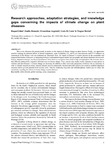Por favor, use este identificador para citar o enlazar este ítem:
http://www.alice.cnptia.embrapa.br/alice/handle/doc/931219Registro completo de metadatos
| Campo DC | Valor | Lengua/Idioma |
|---|---|---|
| dc.contributor.author | GHINI, R. | pt_BR |
| dc.contributor.author | HAMADA, E. | pt_BR |
| dc.contributor.author | ANGELOTTI, F. | pt_BR |
| dc.contributor.author | COSTA, L. B. | pt_BR |
| dc.contributor.author | BETTIOL, W. | pt_BR |
| dc.date.accessioned | 2012-08-14T11:11:11Z | pt_BR |
| dc.date.available | 2012-08-14T11:11:11Z | pt_BR |
| dc.date.created | 2012-08-14 | pt_BR |
| dc.date.issued | 2012 | pt_BR |
| dc.identifier.citation | Tropical Plant Pathology, v. 37, n. 1, p. 5-24, 2012 | pt_BR |
| dc.identifier.uri | http://www.alice.cnptia.embrapa.br/alice/handle/doc/931219 | pt_BR |
| dc.description | This review discusses the present trends in studies on the impacts of climate change on plant diseases. Firstly, the approaches used for studying the potential effects of altered temperature, water availability, CO2 and O3 air concentrations, and UV-B radiation on components of the disease cycle are explained and discussed. Next, the impact of changes in climate patterns on the geographic and temporal distribution of diseases by integrating biological and epidemiological models into geographic and climate databases are assessed. Finally, adaptation strategies are discussed and areas where there is a recognized lack of knowledge are highlighted. The literature shows that different pathosystems respond in different ways to climate change. Thus, case-by-case studies on the responses of crop species or varieties and their diseases to climate change are necessary. In addition to that, wide-scale projections of disease risk are necessary in order to identify research priorities, whereas industry must be strategically directed and public policies developed to establish adaptation measures and to prevent potential food security crisis. Only by conducting long-term and multidisciplinary studies can we reduce the uncertainty regarding the effects of climate change on plant diseases. | pt_BR |
| dc.language.iso | eng | eng |
| dc.rights | openAccess | eng |
| dc.subject | Mudanças climáticas | pt_BR |
| dc.subject | Plant disease and disorders | pt_BR |
| dc.title | Research approaches, adaptation strategies, and knowledge gaps concerning the impacts of climate change on plant diseases. | pt_BR |
| dc.type | Artigo de periódico | pt_BR |
| dc.date.updated | 2012-08-17T11:11:11Z | pt_BR |
| dc.subject.thesagro | Clima | pt_BR |
| dc.subject.thesagro | Doença de planta | pt_BR |
| dc.subject.thesagro | Dióxido de carbono | pt_BR |
| dc.subject.thesagro | Ozônio | pt_BR |
| dc.subject.thesagro | Temperatura | pt_BR |
| dc.subject.nalthesaurus | Global warming | pt_BR |
| dc.subject.nalthesaurus | Carbon dioxide | pt_BR |
| dc.subject.nalthesaurus | Climate change | pt_BR |
| dc.subject.nalthesaurus | Ozone | pt_BR |
| dc.subject.nalthesaurus | Ambient temperature | pt_BR |
| riaa.ainfo.id | 931219 | pt_BR |
| riaa.ainfo.lastupdate | 2012-08-17 | pt_BR |
| dc.contributor.institution | RAQUEL GHINI, CNPMA; EMILIA HAMADA, CNPMA; FRANCISLENE ANGELOTTI, CPATSA; LUCIO BERTOLDO COSTA, UNESP-Botucatu; WAGNER BETTIOL, CNPMA. | pt_BR |
| Aparece en las colecciones: | Artigo em periódico indexado (CNPMA)  | |
Ficheros en este ítem:
| Fichero | Descripción | Tamaño | Formato | |
|---|---|---|---|---|
| 2012AP09.pdf | 9.31 MB | Adobe PDF |  Visualizar/Abrir |









